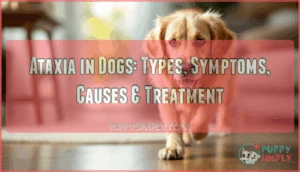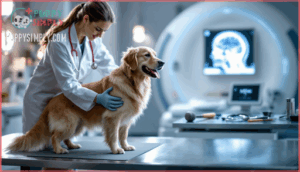This site is supported by our readers. We may earn a commission, at no cost to you, if you purchase through links.
 When your dog suddenly starts walking like they’ve forgotten how their legs work, stumbling through the living room as if the floor is tilting beneath them, you’re witnessing ataxia—a neurological condition that disrupts the brain’s ability to orchestrate smooth, coordinated movement. Unlike muscle weakness, where your dog lacks the strength to move, ataxia means the signals between brain and body have gone haywire, leaving them with plenty of power but no precision.
When your dog suddenly starts walking like they’ve forgotten how their legs work, stumbling through the living room as if the floor is tilting beneath them, you’re witnessing ataxia—a neurological condition that disrupts the brain’s ability to orchestrate smooth, coordinated movement. Unlike muscle weakness, where your dog lacks the strength to move, ataxia means the signals between brain and body have gone haywire, leaving them with plenty of power but no precision.
The cerebellum, spinal cord, or inner ear may be sending scrambled messages, creating those unsteady, drunken-looking steps that range from mildly wobbly to completely incapacitating.
Understanding which type of ataxia your dog has and what’s causing it determines whether you’re dealing with a treatable infection, a medication side effect, or something requiring more intensive intervention.
Table Of Contents
Key Takeaways
- Ataxia disrupts coordination, not strength—your dog’s muscles work fine, but scrambled signals between the brain, spinal cord, or inner ear create unsteady, drunken-looking movements that require identifying which nervous system area is affected.
- The four types of ataxia (cerebellar, proprioceptive, vestibular, and spinocerebellar) produce distinct symptoms—from goose-stepping and head tremors to paw knuckling and eye jerking—that help veterinarians pinpoint whether the problem stems from the brain, spine, inner ear, or inherited genetic mutations.
- Causes range from immediately treatable issues like toxins, infections, and medication side effects to serious conditions like brain tumors, spinal trauma, and progressive degenerative diseases, making early diagnosis critical for the best outcomes.
- Treatment success depends entirely on addressing the underlying cause—whether that’s antibiotics for infection, decontamination for toxins, surgery for structural problems, or supportive care and rehabilitation therapy to help your dog adapt when recovery isn’t possible.
What is Ataxia in Dogs?
If your dog suddenly seems unsteady on their feet, you might be witnessing ataxia—a coordination problem that’s often misunderstood. Ataxia isn’t about weak muscles, but rather a disconnect in how your dog’s nervous system controls movement.
Let’s break down what ataxia actually means, how it differs from simple weakness, and what’s happening inside your dog’s body when coordination goes awry.
Definition and Overview
When your dog’s legs seem to move with a mind of their own, stumbling and swaying like they’ve forgotten how to walk, you’re likely witnessing ataxia—a neurological condition that disrupts the body’s ability to coordinate movement. Ataxia, defined simply, means your dog’s nervous system can’t properly manage voluntary muscle control, creating uncoordinated movements despite normal muscle strength. Understanding ataxia helps you recognize this neurological symptom affecting canine coordination and balance:
- It’s a symptom, not a disease – Ataxia signals an underlying health issue affecting movement control
- The cerebellum is often involved – This brain region coordinates smooth, purposeful movements
- Strength remains intact – Unlike weakness, ataxia disrupts coordination while muscles stay strong
- Multiple nervous system areas can be affected – Different locations produce distinct movement patterns
How Ataxia Differs From Muscle Weakness
The key difference between ataxia and muscle weakness lies in what’s actually failing—your dog with ataxia has perfectly strong muscles that simply can’t follow the brain’s instructions for coordinated movement, while a weak dog lacks the muscle power to move properly in the first place.
Ataxia disrupts coordination despite strong muscles, while weakness drains power but leaves neurological control intact
Think of it this way: ataxia affects coordination without touching strength, whereas weakness (called paresis) drains power while leaving the neurological control intact.
This distinction matters because overlapping symptoms can create diagnostic challenges, requiring careful observation of how your dog’s mobility changes to identify whether the nervous system’s signaling or the muscles themselves need attention.
Role of The Nervous System
Understanding this coordination puzzle starts with recognizing that your dog’s nervous system acts like an incredibly intricate communication network, sending constant messages between the brain, spinal cord, and body to orchestrate every single movement.
The cerebellum function centers on fine-tuning these neural pathways, while the brainstem impact extends to balance and spatial awareness.
When neurological disorders interrupt sensory perception anywhere along this network, ataxia in dogs develops—coordination falters even though muscle strength remains intact, signaling neurological problems in dogs that require a thorough neurologic exam.
Types of Ataxia in Dogs
When your dog’s movement seems off, understanding which type of ataxia they’re experiencing helps point you toward the right answers. Veterinary neurologists break canine ataxia into distinct categories based on which part of the nervous system isn’t working properly.
Let’s look at the four main types you should know about.
Cerebellar Ataxia
When your dog’s cerebellum—the brain’s coordination center—isn’t working properly, you’ll notice movements that look more like a puppet on tangled strings than a smooth, controlled gait.
Cerebellar function disorders often stem from infections like canine distemper, tumors pressing on brain tissue, or genetic factors in certain breeds.
You’ll see distinctive goose-stepping, head tremors, and balance loss as neurological disorders progress—symptoms that demand immediate veterinary care.
Proprioceptive Ataxia
If your dog’s paws start knuckling under or their toes drag like they’ve forgotten where the ground is, their spinal cord may be failing to send proper position signals—a hallmark of proprioceptive ataxia.
Spinal cord lesions disrupt leg position awareness, causing stumbling and swaying as your dog loses track of where their limbs are in space. You’ll notice paws bending under during walks, creating an unsteady, uncoordinated appearance that requires prompt veterinary evaluation to determine appropriate treatment strategies.
Vestibular Ataxia
The inner ear and brainstem work like your dog’s internal GPS—so when problems strike these areas, your pet loses their sense of balance and direction, a condition called vestibular ataxia.
You’ll spot head tilting, circling, and nystagmus (eyes darting side to side) as your dog leans or stumbles in unpredictable directions. Inner ear infections and brainstem lesions commonly trigger these balance deficits, requiring veterinary neurology expertise to distinguish peripheral from central vestibular syndrome.
Spinocerebellar Ataxia
Unlike acquired forms of ataxia, spinocerebellar ataxia in dogs stems from inherited genetic mutations that destroy cerebellar neurons over time. You’ll notice symptoms like tremors and coordination loss appearing in young puppies—often before six months—with breed predisposition seen in Jack Russell Terriers and Parson Russell Terriers.
Genetic testing permits early detection, allowing you to plan management strategies since this progressive neurological disorder currently has no cure. A common sign is an abnormal gait.
Recognizing Symptoms of Ataxia
When your dog’s movements seem off, pinpointing the exact signs can help you understand what’s happening. Ataxia shows up in specific ways depending on which part of the nervous system is affected.
Let’s look at the telltale symptoms you might notice in your dog.
Abnormal Gait and Movement
One of the first things you’ll notice when your dog has ataxia is how they walk—their gait becomes unsteady, almost as if they’re traversing an invisible obstacle course.
These gait abnormalities reveal coordination issues, like weaving side-to-side or adopting a wide stance to compensate for balance deficits. You might see them stumbling or tipping unexpectedly, movement patterns that signal disrupted communication between their nervous system and muscles.
Head Tremors and Loss of Balance
Beyond the wobbly walk, you may notice your dog’s head shaking involuntarily or watch them lose their balance even while standing still. These balance problems signal neurological disorders affecting coordination centers in the brain.
Here’s what you might observe with canine ataxia symptoms:
- Tremor characteristics: Rhythmic head movements that worsen with intentional actions
- Balance compensation: Wide-legged stance to prevent tipping over
- Severity correlation: More pronounced tremors often indicate greater neurological involvement
- Progression timeline: Symptoms may develop gradually or appear suddenly
- Impact on life: Daily activities like eating or drinking become challenging
Goose-Stepping and Toe Dragging
If your dog’s legs suddenly lift high like a marching band performer, or their toes scrape the ground with every step, you’re witnessing two hallmark signs of cerebellar dysfunction. This exaggerated gait happens because spinal lesions or nerve damage disrupt the proprioceptive signals your dog needs for smooth movement.
Movement analysis during early detection helps distinguish proprioceptive ataxia from other neurological symptoms affecting dog balance and coordination, guiding your veterinarian toward the right diagnosis for canine ataxia symptoms.
Nystagmus and Circling Behavior
When your dog’s eyes start jerking side to side on their own, or they walk in tight circles like they’re chasing an invisible tail, you’re likely seeing vestibular ataxia—a sign that something’s affecting the inner ear or brainstem balance centers.
These neurological symptoms reveal how vestibular dysfunction creates behavioral changes that differ from cerebellar or proprioceptive ataxia, making pattern recognition essential for determining the neurological impact on your dog’s coordination.
Common Causes of Ataxia
Understanding what triggers ataxia can help you recognize warning signs early and seek proper veterinary care. The underlying causes range from immediate threats like toxins to long-term conditions affecting your dog’s nervous system.
Let’s examine the main categories that can lead to this coordination disorder.
Neurological Diseases and Injuries
Neurological diseases and injuries stand among the most serious culprits behind ataxia, disrupting the delicate wiring that keeps your dog’s movements smooth and coordinated. These conditions directly damage the brain, spinal cord, or peripheral nerves, leading to the uncoordinated movements seen during neurological exams.
- Brain tumors press against surrounding tissue, interfering with signal transmission
- Encephalitis causes inflammation that disrupts normal brain function
- Spinal trauma from accidents severs critical nerve pathways
- Degenerative myelopathy progressively destroys spinal cord tissue
- Nerve damage from compression or disease blocks communication between brain and limbs
Infections, Toxins, and Drugs
Your dog’s environment can sometimes be just as dangerous as any disease, with certain infections, toxins, and even medications triggering ataxia seemingly out of nowhere. Xylitol toxicity from sugar-free products, marijuana exposure, and medication overdoses from drugs like phenobarbital can all disrupt coordination.
Encephalitis from infection inflames brain tissue, while toxin ingestion requires immediate attention. Drug-induced ataxia may resolve once you stop the problematic medication, but toxin prevention remains your best defense against these environmental threats.
Inherited and Metabolic Disorders
Some dogs inherit genetic mutations that sabotage their metabolic pathways, leading to neurological disorders like spinocerebellar ataxia. Certain breeds show breed predisposition to these conditions, where enzyme deficiencies disrupt normal coordination.
Metabolic diseases such as hypoglycemia can also trigger ataxia in dogs, and dietary impact matters—feeding dogs inappropriate foods affects their neurological health.
A key sign is a loss of coordination. Recognizing these causes of ataxia helps guide treatment options for ataxia specific to each dog’s underlying condition.
Diagnosing Ataxia in Dogs
When your dog shows signs of uncoordinated movement, your veterinarian will need to determine what’s causing the problem and which part of the nervous system is affected.
This process involves multiple steps, each helping to narrow down the underlying cause. Here’s what you can expect during the diagnostic journey.
Taking a Thorough Medical History
Before prescribing a single test, veterinarians piece together clues from your dog’s past—recent exposures, medication changes, chronic conditions—to narrow down what might be disrupting the nervous system. Owner observations about when neurological symptoms started matter immensely.
Your vet will ask about breed predispositions, medication history, environmental factors like toxin exposure, and diet analysis. These details guide the canine ataxia diagnosis, helping rule out reversible causes before moving to neurologic exams.
Observing Gait and Movement
Watching how your dog walks, stands, and shifts weight tells a veterinarian more about nervous system function than almost any other single observation. Gait abnormalities reveal which part of the nervous system is affected, helping pinpoint whether the issue involves the cerebellum, spinal cord, or vestibular apparatus.
During examination, your vet looks for:
- Balance deficits like swaying, tipping, or leaning to one side
- Movement patterns including wide-based stance or crossing limbs
- Posture changes such as paws knuckling under or abnormal head positioning
- Neurological symptoms like circling, goose-stepping, or toe dragging
These observations directly inform which type of ataxia your dog may have.
Neurologic Examination
A thorough neurologic exam builds on gait observation, testing specific reflexes, sensory responses, and cranial nerve function to map exactly where the nervous system breakdown is occurring. Your veterinarian systematically evaluates each component:
| Exam Component | What’s Tested | What It Reveals |
|---|---|---|
| Reflex Assessment | Spinal reflexes, patellar responses | Spinal cord integrity, nerve pathway function |
| Cranial Nerves | Eye movement, facial sensation, swallowing | Brainstem and vestibular involvement |
| Postural Reactions | Paw placement, proprioception | Spinal cord lesions causing proprioceptive ataxia |
| Mental Status | Alertness, responsiveness | Brain function, metabolic issues |
| Palpation Techniques | Muscle tone, pain response | Inflammation, injury, neurological disorders |
These neurologic exams pinpoint canine ataxia diagnosis with precision, distinguishing between cerebellar, vestibular, and proprioceptive causes while ruling out other neurological symptoms.
Laboratory Tests and Imaging
Once the neurologic exam narrows down the affected area, blood work, urine analysis, and sophisticated imaging step in to reveal the "why" behind the dysfunction—whether it’s a hidden infection, a metabolic imbalance, or a structural problem lurking in the brain or spine.
Blood analysis detects metabolic disorders or toxin exposure, while urine samples screen for underlying systemic disease. Imaging techniques like MRI or CT scans visualize brain tumors, spinal lesions, or inflammation affecting canine neurology.
In some cases, CSF analysis confirms infections or inflammatory conditions, and genetic testing identifies inherited forms of ataxia in dogs during veterinary diagnosis. Thus, neurologic exams lead to targeted medical imaging and accurate treatment plans.
Treatment Options for Ataxia
Once your veterinarian identifies the root cause of your dog’s ataxia, they’ll develop a treatment plan designed for the specific condition affecting your pet. Treatment approaches vary widely depending on whether the problem stems from infection, toxicity, injury, or disease.
The following options represent the main strategies veterinarians use to address ataxia and help restore your dog’s coordination.
Addressing Underlying Causes
Treatment success hinges on identifying and resolving the root problem causing your dog’s coordination issues. Your veterinarian will tailor the approach based on whether ataxia diagnosis and treatment reveal neurological problems in dogs, infections, or toxins.
Common treatment options for ataxia addressing causes include:
- Infection treatments: Antibiotics or antivirals for encephalitis
- Toxin removal: Decontamination and supportive care
- Injury rehabilitation: Rest and anti-inflammatory medications
- Disease management: Surgery or chemotherapy for tumors
- Genetic counseling: Breed-specific guidance for inherited conditions
Medications and Therapies
Beyond targeting the root cause, specific medications and supportive therapies can directly manage symptoms and improve your dog’s daily function. Your veterinarian may prescribe treatments based on the severity and type of ataxia, considering potential drug side-effects alongside benefits.
| Treatment Category | Examples | Purpose |
|---|---|---|
| Medications | Anti-nausea drugs, corticosteroids | Control vestibular symptoms, reduce inflammation |
| Surgical Interventions | Tumor removal, decompression | Address structural causes |
| Supportive Therapies | Balance aids, dietary adjustments | Improve quality of life |
Treatment options often combine veterinary care with rehabilitation protocols. Alternative therapies like acupuncture may complement conventional medications, while palliative care focuses on comfort when recovery isn’t possible. Your veterinarian will guide you through rehabilitation therapy options and ongoing dog care and management strategies adapted to your pet’s needs.
Physical Rehabilitation for Dogs
When traditional medications alone aren’t enough, working with a canine rehabilitation therapist can help your dog rebuild coordination, strength, and confidence through targeted physical exercises. These rehab techniques focus on neurological conditions in dogs, supporting recovery through veterinary care and rehabilitation therapy.
- Hydrotherapy benefits include buoyancy that reduces joint stress while improving balance and gait
- Home exercises like controlled walking patterns and balance board training strengthen proprioception
- Assistive devices such as slings or harnesses provide stability during movement retraining
- Recovery timeline varies with ataxia in dogs severity, requiring ongoing assessment of dog health progress
Supporting a Dog With Ataxia
Once your veterinarian has diagnosed your dog and begun treatment, your focus shifts to making daily life easier and safer at home. Dogs with ataxia need a modified environment to prevent injuries and reduce stress as they navigate their coordination challenges.
Here’s how you can support your dog through this condition.
Ensuring Home Safety and Comfort
For dogs managing life with ataxia, your home can become either a safe haven or an obstacle course, depending on how you adapt the space to their changing needs. Simple modifications make a significant difference in dog safety and care. Focus on these key areas:
| Safety Priority | Recommended Changes |
|---|---|
| Flooring & Traction | Add non-slip rugs or yoga mats to prevent sliding; avoid slick hardwood or tile |
| Environmental Hazards | Use corner padding on furniture; install dog gates at stairs to prevent falls |
| Comfort & Support | Provide orthopedic bedding at ground level; consider harnesses or slings as assistive devices |
Mental enrichment through puzzle feeders keeps your dog engaged while accommodating their mobility limitations, supporting overall dog health and wellness.
Prognosis and Long-Term Management
Your dog’s outlook depends heavily on what’s causing the ataxia. Recovery rates vary widely—some dogs bounce back completely, while others need ongoing veterinary care and advice throughout their lives.
Medications like gabapentin help manage chronic pain, though about 10% of dogs experience sedation as a side effect. Supportive care, including routine checkups and pain management, maintains quality of life and aids in relapse prevention, which matters since roughly half of dogs experience symptom return within seven months of initial treatment.
When to Contact Your Veterinarian
If your dog suddenly loses coordination, can’t stand without wobbling, or shows unusual eye movements, don’t wait—these signs need immediate veterinary attention. Rapid symptom progression or worsening condition signals that the underlying causes of ataxia may be advancing.
Contact your veterinarian immediately if you notice:
- Sudden ataxia onset with complete loss of coordination
- Concurrent illnesses like vomiting, seizures, or breathing difficulties
- Home treatment ineffectiveness after 24 hours
- Progressive inability to walk or stand
- Acute changes in consciousness or responsiveness
Early veterinary diagnosis of canine neurological disorders improves outcomes considerably.
Frequently Asked Questions (FAQs)
Can ataxia in dogs be prevented?
Prevention isn’t always possible, but genetic screening helps identify breed predispositions before symptoms appear.
Vaccination protocols protect against infections like canine distemper, while toxin avoidance and pet safety measures reduce environmental risks.
Early intervention through regular veterinary care improves outcomes.
Which dog breeds are most prone to ataxia?
Certain breeds carry genetic predispositions to inherited forms of ataxia due to breed-specific mutations. Jack Russell Terriers, Coton de Tulear, and Parson Russell Terriers face higher ataxia prevalence, making screening programs and responsible breeding essential for canine health.
Is ataxia painful for dogs?
Ataxia itself usually doesn’t cause pain, but your dog may experience discomfort from the underlying condition causing the neurological disorder.
Nerve damage, injuries, or infections affecting coordination can lead to secondary pain, impacting quality of life and requiring appropriate pain management alongside treatment.
How quickly does ataxia progress in dogs?
Progression timeline varies widely depending on the underlying cause. Acute conditions, like toxin exposure, may resolve quickly with treatment.
Inherited neurological disorders often worsen gradually over months or years, impacting quality of life and requiring ongoing veterinary medicine support.
Can diet help manage ataxia symptoms?
While diet doesn’t directly treat ataxia’s neurological causes, proper nutrition aids overall health. Weight management prevents additional strain on coordination, and hydration importance can’t be overstated for nervous system function.
Some supplements may offer benefits depending on the underlying condition.
Conclusion
Your dog’s body knows how to walk—the muscles work, the legs are strong—but ataxia in dogs scrambles the map between brain and movement, leaving coordination lost in translation. Whether the culprit hides in the cerebellum, vestibular system, or spinal pathways, recognizing the stumble patterns early gives you the best chance at reversing or managing the disruption.
Watch their gait, trust your instincts, and move quickly when something feels off—because with ataxia, timing isn’t just helpful, it’s everything.
- https://vet.osu.edu/people/ronaldo-da-costa
- https://www.akcchf.org/educational-resources/library/articles/articles/cerebellar-ataxia-ca-in-the.html
- https://www.merriam-webster.com/medical/hypermetria
- https://www.webmd.com/pets/dogs/what-to-know-nystagmus-in-dogs
- https://www.goodrx.com/pet-health/dog/dog-stroke-symptoms















